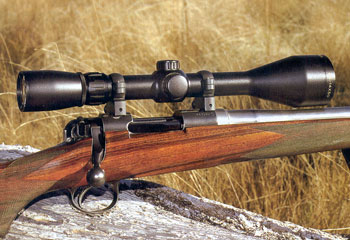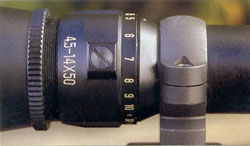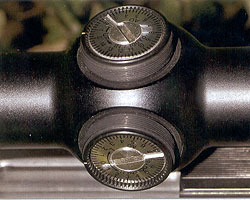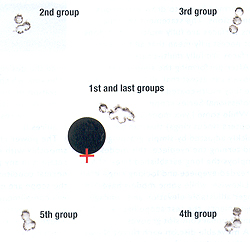 P4.5-14x50D By Erin Boyd
P4.5-14x50D By Erin Boyd P4.5-14x50D By Erin Boyd
P4.5-14x50D By Erin Boyd
There are a wide variety of models available, including various hunting types, wide angle, vari-powers, fixed-power, illuminated reticle and large objectives, up to 56mm. The tube sizes on offer are 1” (25.4mm) and 30mm for hunting scopes. Lynx also manufactures dedicated targets, silhouette, varmint, military, handgun and 33mm red dot scopes, plus an extensive selection of binoculars. The brand is constantly evolving with new models being introduced at regular intervals.
The rugged conditions in South Africa are a good proving ground for scopes, and the Lynx range has developed a reputation for sound construction and reliability, offering good quality optics at a fair price. Australia shooters have also given Lynx Optics their recommendation.
Malcolm Gault of Gault Pty Ltd is the Australian Importer and distributor and has recently made the line available in New Zealand. Gabe Zigilani of High Country Sports in Fairlie, South Canterbury is the New Zealand agent.
I recently received a Lynx P4.5-14x50D vari-power to review. The scope came well packed in a black box with a robust Styrofoam insert that efficiently cradled it against damage in transit. See-through lens caps, a lens cleaning cloth, and a 15 year non-transferable warranty were included, as was a comprehensive booklet covering scope mounting, steel mounts and ring options. The booklet also contained sections on sighting in, plus problems and solutions with scope alignment. The scope was accompanied by a set of 24.5mm (1”) Lynx Quick Detach rings which enabled me to install the scope on the 18mm integral rails on my BSA test rifle.
This model is from the Lynx Professional Range which features aircraft grade monotube construction. They are rated shockproof and waterproof, and come nitrogen purged, with full multi-coating on all lens surfaces to aid light transmission.
There is a little trick some gun scope manufacturers play regarding lens coating, which is easily checked by shining a torch into the objective lens and looking at the small circles reflected back onto the front element from the internal surfaces. If only the front and rear elements are multi-coated then the other lenses will show as white circles. However, if all the lens surfaces are indeed fully multi-coated then you will see a series of different coloured circles beaming back at you.
Yes some manufacturers only tell par of the story and leave the uninformed buyer to draw erroneous conclusions. The statement that the lens surfaces are multi-coated does not necessarily mean that all the lens surfaces are multi-coated.
After performing the simple test above, I can attest that all lens surfaces are fully milti-coated in this Lynx Professional Scope.
While some Lynx models have diopters (focus rings) that can be quickly adjusted by simply grasping and turning the eyepiece, this model employs the long established fine-threaded eyepiece and locking ring.
Likewise while some models have finger adjustable elevation and windage adjustments, the test scope has conventional coin slot grooves.
A moveable disc on each turret allows for the settings to be returned to zero once the desired point of aim has been achieved, which means that any minor elevation or windage adjustments made later are easy to keep track of. The zero can be reset any time the shooter requires it.
 |
The Power adjustment ring turns smoothly, but offers enoguh resistance to maintain its position under hunting conditions |
| Lynx Professional series scopes are of monotube (0ne piece) aircraft grade aluminium construction. The adjustment dials on this model employ the standard coin slot method. Dials can be reset to zero after sighting-in. |  |
The power change ring moved smoothly with enough friction to retain it in any position I set it to under normal conditions. The fit and finish of the scope are of a high standard, and will compliment any rifle. After the initial inspection I put the Lynx in the freezer for the night, then the following morning warmed it up to room temperature before immersing it in a tub of water. This rigorous test revealed no evidence of fogging or leaking. After drying the scope off I set the BSA up on my desk with a Harris Bipod attached, then with the scope resting loosely in the rings, established the correct orientation and eye relief for me. This scope was then secured into the Quick Detach Lynx steel rings provided.
Incidentally, when a vari-power scope is on maximum power you have to move your eye closer to the lens to achieve a full sight picture, so it is best to have the scope at the highest power setting when you’re installing it in the rings. This avoids the likeliness f “Weather by eyebrow” – The injury many shooters suffer when they have their eyes too close to the scope on a hard kicking rifle – Weather by Magnum cartridges being notorious in this respect.
Using a Bushnell boresighter I now adjusted the Duplex crosshairs onto the centre of the grid pattern. Doing this beforehand saves time and ammunition during the sighting-in process at the range. At this time, looking carefully at the reticle superimposed onto the collimator’s central cross, I wound the Lynx right through its power range to see if its point of aim changed. No changes were detected at any power setting.
 |
For laod development work the editor installed the Lynx on his recently rebarrelled Sako deer rifle... |
Reliability Test:
Given the autumn weather I had to wait a week or two to get the still, calm conditions necessary to carry out this test. In the meantime I loaded up some well proven benchrest spec loads for my .223 Varminter, consisting of neck-turned Federal Match cases with their flash holes and primer pockets uniformed, trimmed to length and neck-sized in Wilson straight line dies. The projectiles I se for varminting these days are molycoated Hornaday 5 grain V-max, supplied by Steve’s wholesale in Wellington, the Hornady Importer.
Seated out to just touch the rifling, these projectiles have proven very accurate and humane killers in my beloved BSA, as well as many other rifles, so they are more than suitable for the test. The other components of the load are Federal Match small rifle primers and 25.5 grains of ADI Benchmark 2, metered through a Redding powder mixture.
As the scope has a relatively high maximum power of 14x, I felt confident that I would be able to get some good groups. But I also wanted to see if the Lynx would return to its original point of aim after being adjusted in a clockwise rotation around the target.
On a lovely afternoon o my range at Mount Vernon Station, I used my Leica LRF rangefinder to measure out 100 yards between the target and my portable benchrest.
The initial shot was about six inches high (150mm) and about four inches (100mm) to the right, with my aiming point being the 6 o’clock position on the ¾” black dot – indicated by the red cross in the photo.
I adjusted the elevation and windage knobs to compensate and fired a test shot that went just above the dot and 18mm to the right. As I instinctively reached forward to adjust the crosshairs onto the aiming point, it suddenly occurred to me that I would be unnecessarily firing good varmint rounds at a piece of paper. If the lynx passed the test then I only needed to move the reticule three clicks to the left to have the rifle sighted-in for a 200 metre point blank zero. Why not save a couple of rounds and enjoy some real varminting?
I therefore decided to start the repeatability test from that setting. The ¼ MOA clicks are a little difficult to feel positively and the clicks very faint to hear, so I used the one MOA graduations on the discs to affect the point of impact changes – still using the 6 o’clock position on the dot as my aiming point. As can be seen from the target photo below the results were excellent and the graduations worked out to be very precise.
 |
The repeatability of the Lynx was first class - as the scope was adjusted the groups moved around the target and back to the centre with precision. |
After completing the test I moved the reticule three clicks out to the left and began packing my equipment. On the way back across the property a few minutes later I spotted two magpies in a paddock – “187 metres” my Leica rangefinder reliably informed me. “Thanks” I whispered back “That’s point blank range!”
I turned off the ignition, stealthily got out of the car, reclaimed the bagged rifle off the back seat, replaced the bolt and the Harris bipod, arranged the rifle across the conveniently flat boot of my car, slipped a round into the magazine and settled the crosshairs at 14x on the chest of the nearest varmint. Boom! Instant feather duster! The other magpie leaps into the air at the shot and flew around in a circle before landing again and running across to find out what had happened. Meanwhile I had slipped another round up the spout – which rapidly sent the second bird to magpie nirvana.
I have seen this pattern many times. While they may be pests in their own right, magpies are extremely loyal will often return to a downed bird to check things out. Be prepared and you’ll often get two – after all, it’s the decent thing to do, it saves the mate from pining!
 |
The author uses this set-up to produce some extremely accurate varmint loads. The dies and press are the Wilson straight line type. |
Optics:
This scope has a relatively long zoom range, 4.5x – 14x. The field is flat and sharp right out to the edges up to 10 power, although there is some degradation of the field of view (FOV) from there on. On 14 power, looking at a line of warratahs running along a ridge about 800 metres away, the FOV was clear and sharp in the centre while the outer edges of the image were slightly blurry. This aberration is called astigmatism. It is a common occurrence in both camera lenses and rifle scopes with a long zoom range. For hunting purposes the high magnification compensates to some extent for this perimeter aberration. The image provided by the Lynx is a crisp with good colour rendition in the best optical range of the scope (4.5-10x) But it is still very useable at the top end (14x), as the target photos show above.
Low light capability is good up to 7 power with exit pupil of 7.1.